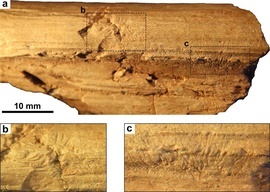Mammalian feeding traces on a Sauropod Dinosaur bone from the Late Jurassic of northwestern China.
[sciencythoughts.blogspot.com]
For more than 160 million years, Mammals lived in the shadow of the Dinosaurs, remaining small and elusive with an average adult body size close to 100 g. Nonetheless, recent discoveries demonstrate that Mesozoic Mammals were ecologically diverse and occupied various ecological niches. They ranged from ground-dwelling generalists to specialists with semi-aquatic, fossorial, arboreal and even gliding habits. This ecological diversity suggests an equally varied diet, probably encompassing herbivory, insectivory, carnivory and omnivory. The reconstruction of the diet and feeding behaviour of Mesozoic Mammals is, however, largely based on circumstantial evidence such as tooth morphology. Direct evidence for feeding behaviour is scarce and so far limited to a stomach content from the Early Cretaceous, and four instances of feeding traces on bones from the Late Cretaceous.



Enjoy being online again!
Welcome to the community of good people who base their values on evidence and appreciate civil discourse - the social network you will enjoy.Create your free account
Recent Visitors 11
Notlost
Northeastern Oklahoma,
Cast1es
Houston,
dalefvictor
Astoria,
t1nick
Western,
StarvingArtist
Tahlequah,OK Fayetteville,AR,
Photos 292 More
Posted by JoeBKite-like structures in the western Sahara Desert.
Posted by TriphidAn Aussie Indigenous Message Stick.
Posted by TriphidIndigenous Australian Aboriginal Rock art dated somewhere between 20 and 30 thousand years old.
Posted by TriphidIndigenous Australian Aboriginal Rock art dated somewhere between 20 and 30 thousand years old.
Posted by TriphidIndigenous Australian Aboriginal Rock art dated somewhere between 20 and 30 thousand years old.
Posted by TriphidIndigenous Australian Aboriginal Rock art dated somewhere between 20 and 30 thousand years old.
Posted by JoeBDortoka vremiri: A new species of Dortokid Turtle from the Late Cretaceous of the Hațeg Basin, Romania.
Posted by JoeBThe Cabeço da Amoreira burial: An Early Modern Era West African buried in a Mesolithic shell midden in Portugal.
Posted by JoeBMusivavis amabilis: A new species of Enantiornithine Bird from the Early Cretaceous Jehol Biota of northeastern China.
Posted by JoeBTorosaurus in Canada.
Posted by JoeBStone tools from the Borselan Rock Shelter, in the Binalud Mountains of northeastern Iran.
Posted by JoeBDating the Lantian Biota.
Posted by JoeBBashanosaurus primitivus: A new species of Stegosaur from the Middle Jurassic of Chongqing Municipality, China.
Posted by JoeBDetermining the time of year when the Chicxulub Impactor fell.
Posted by JoeBSão Tomé and Príncipe: Possibly the last country on Earth never to have been visited by a working archaeologist.
Posted by JoeBMambawakale ruhuhu: A new species of Pseudosuchian Archosaur from the Middle Triassic Manda Beds of Tanzania.





